Application of Grafting Method in Resistance Identification of Sweet Potato Virus Disease and Resistance Evaluation of Elite Sweet Potato [Ipomoea batatas (L.) Lam] Varieties
Abstract
1. Introduction
2. Results
2.1. Comparison of Two Grafting Methods
2.2. Symptomatic Test and Cluster Analysis
2.3. NCM-ELISA Identification
2.4. QRT-PCR Analysis
3. Discussion
4. Materials and Methods
4.1. Comparison of Two Grafting Methods
4.1.1. Plant Materials
4.1.2. Experimental Design
4.1.3. Grafting
4.1.4. Grafting Survival Rate Calculation
4.2. Identification of Resistance to SPVD in Sweet Potato
4.2.1. Plant Materials
4.2.2. Virus Inoculation
4.2.3. Disease Index Calculation and Cluster Analysis
4.2.4. NCM-ELISA
4.2.5. RT-qPCR Detection
4.3. Statistical Analysis
5. Conclusions
Author Contributions
Funding
Data Availability Statement
Conflicts of Interest
References
- Barkessa, M.K.E. A review on sweet potato (Ipomea batatas) viruses and associated diseases. Int. J. Res. Agric. 2018, 5, 1–10. [Google Scholar]
- Cuellar, W.J.; Kreuze, J.F.; Rajamäki, M.-L.; Cruzado, K.R.; Untiveros, M.; Valkonen, J.P.T. Elimination of antiviral defense by viral RNase III. Proc. Natl. Acad. Sci. USA 2009, 106, 10354–10358. [Google Scholar] [CrossRef] [PubMed]
- Tairo, F.; Mukasa, S.B.; Jones, R.A.C.; Kullaya, A.; Rubaihayo, P.R.; Valkonen, J.P.T. Unravelling the genetic diversity of the three main viruses involved in Sweet Potato Virus Disease (SPVD), and its practical implications. Mol. Plant Pathol. 2005, 6, 199–211. [Google Scholar] [CrossRef]
- Untiveros, M.; Quispe, D.; Kreuze, J. Analysis of complete genomic sequences of isolates of the Sweet potato feathery mottle virus strains C and EA: Molecular evidence for two distinct potyvirus species and two P1 protein domains. Arch. Virol. 2010, 155, 2059–2063. [Google Scholar] [CrossRef] [PubMed]
- Gibson, R.W.; Aritua, V. The perspective of sweetpotato chlorotic stunt virus in sweetpotato production in Africa: A review. Afr. Crop Sci. J. 2002, 10, 281–310. [Google Scholar] [CrossRef]
- Kwak, H.-R.; Kim, J.; Kim, M.-K.; Seo, J.-K.; Jung, M.-N.; Kim, J.-S.; Lee, S.; Choi, H.-S. Molecular Characterization of Five Potyviruses Infecting Korean Sweet Potatoes Based on Analyses of Complete Genome Sequences. Plant Pathol. J. 2015, 31, 388–401. [Google Scholar] [CrossRef]
- Kreuze, J.F.; Savenkov, E.I.; Valkonen, J.P.T. Complete Genome Sequence and Analyses of the Subgenomic RNAs of Sweet Potato Chlorotic Stunt Virus Reveal Several New Features for the Genus Crinivirus. J. Virol. 2002, 76, 9260–9270. [Google Scholar] [CrossRef] [PubMed]
- Ngeve, J.M.; Bouwkamp, J.C. Effects of Sweet Potato Virus Disease (SPVD) on the Yield of Sweet Potato Genotypes in Cameroon. Exp. Agric. 1991, 27, 221–225. [Google Scholar] [CrossRef]
- Njeru, R.W.; Mburu, M.W.K.; Cheramgoi, E.; Gibson, R.W.; Kiburi, Z.M.; Obudho, E.; Yobera, D. Studies on the physiological effects of viruses on sweet potato yield in Kenya. Ann. Appl. Biol. 2004, 145, 71–76. [Google Scholar] [CrossRef]
- Li, J.; Gao, G.C.; Li, B.; Zhu, Z.M. Advance on virus-free plant tissue culture and its application on Crocus sativus L. Biotechnol. Bull. 2014, 7, 44–48. (In Chinese) [Google Scholar]
- Xie, L.; Lv, M.F.; Dong, F.L.; Rao, J.F.; Hong, J. Molecular identification of viral pathogens in crocus sativus. Chin. Tradit. Herb. Drugs 2013, 44, 1033–1036. (In Chinese) [Google Scholar]
- Phillips, G.C.; Collins, G.B. Virus Symptom-Free Plants of Red Clover Using Meristem Culture 1. Crop Sci. 1979, 19, 213–216. [Google Scholar] [CrossRef]
- You, Y.P.; Pen, S.Y.; Zhu, W.Y.; Wang, L.; Jian, J.F.; Chen, S.M.; Fan, W.M.; Guan, Z.Y.; Chen, F.D. Study on the elimination of chrysanthemum virus B by using meristem-tip culture. J. Nanjing Agric. Univ. 2013, 36, 144–148. (In Chinese) [Google Scholar]
- Karyeija, R.F.; Gibson, R.W.; Valkonen, J.P.T. The Significance of Sweet Potato Feathery Mottle Virus in Subsistence Sweet Potato Production in Africa. Plant Dis. 1998, 82, 4–15. [Google Scholar] [CrossRef] [PubMed]
- Ames, T.; Smit, N.E.J.M.; Braun, A.R.; O’Sullivan, J.N.; Skoglund, L.G. Sweetpotato Major Pests, Diseases, and Nutritional Disorders; International Potato Center (CIP): Lima, Peru, 1997. [Google Scholar]
- Wang, Q.M.; Wang, Y.X.; Wang, J.J.; Xi, G.H. Advances in virus diseases of sweet potato. Shandong Agric. Sci. 1994, 4, 36–39. (In Chinese) [Google Scholar]
- Aritua, V.; Alicai, T.; Adipala, E.; Carey, E.; Gibson, R.W. Aspects of resistance to sweet potato virus disease in sweet potato. Ann. Appl. Biol. 1998, 132, 387–398. [Google Scholar] [CrossRef]
- Lu, H.X.; Lv, C.W.; Wu, Z.D.; Luo, K.; Yin, W.; Yang, H.; Wang, J.C.; Zhang, K. Development of detection method for sweet potato feathery mottle virus (SPFMV) and sweet potato chlorotic stunt virus(SPCSV) through fluorescence quantitative RT-PCR. Sci. Agric. Sin. 2016, 49, 90–102. (In Chinese) [Google Scholar]
- Dietmar, S.; Youssef, R.; Giuseppe, C.; Jan, H. Grafting as a tool to improve tolerance of vegetables to abiotic stresses: Thermal stress, water stress and organic pollutants. Entia Hortic. 2010, 127, 162–171. [Google Scholar]
- Wu, F.Z.; An, M.J. Effects of watermelon cultivars with different resistances to Fusarium oxysporum f.sp. niveum and grafting on rhizosphere soil microorganism population and community structure. Entia Agric. Sin. 2011, 44, 4636–4644. (In Chinese) [Google Scholar]
- Ye, L.; Zhao, X.; Li, J.S.; Zhang, G.D.; Jing, Y.C. Effects of different rootstocks on growth, yield and quality of greenhouse watermelon. J. Chang. Veg. 2013, 16, 32–35. (In Chinese) [Google Scholar]
- Yang, H.H.; Li, J.F. The anatomical observation of different root stock of healing process on the grafted cucumber pumpkin. North. Hortic. 2014, 8, 5–8. (In Chinese) [Google Scholar]
- Yuan, T.T.; Zhong, Q.P.; Ding, S.J.; Cao, L.Q.; Yan, C.; Yuan, Y.Q.; Huan, Z.; Zhang, X.H. Effects of different stocks and scions on the development and growth of camellia oleifera nurse seed grafting. Acta Agric. Univ. Jianxinesis 2016, 38, 1076–1085. (In Chinese) [Google Scholar]
- Zhang, X.X.; Wang, X.F.; Ling, J.C.; Yu, J.C.; Huan, L.F.; Dong, Z.Y. Sweet potato virus diseases(SPVD): Research progress. Chin. Agric. Sci. Bull. 2019, 35, 118–126. (In Chinese) [Google Scholar]
- Mwanga, R.O.M.; Yencho, G.C.; Gibson, R.W.; Moyer, J.W. Methodology for Inoculating Sweetpotato Virus Disease: Discovery of Tip Dieback, and Plant Recovery and Reversion in Different Clones. Plant Dis. 2013, 97, 30–36. [Google Scholar] [CrossRef]
- Ma, L.; Zhang, C.; Zhou, Y. Progress of study on sweet potato viruses detection techniques. Chin. Agric. Sci. Bull. 2005, 21, 88. [Google Scholar]
- Lu, H.X. Monitoring and Transcriptome Analysis of the Infection of Sweet Potato Virus Disease (SPVD) in Sweet Potato. Master’s Thesis, Southwest University, Chongqing, China, 2016. [Google Scholar]
- Dong, Y.M.; Wang, C.Q.; Zhao, X.; Xiao, C.H.; Chen, W.; Sun, J.L.; Jiao, Z.G. Influences of different grafting methods on the plant growth and fruit characters of muskmelon. Zhongguo Gua-Cai 2017, 30, 34–37. (In Chinese) [Google Scholar]
- Ma, P.Y.; Jia, Z.D.; Bian, X.F.; Guo, X.D.; Xie, Y.Z. Effect of different rootstocks and grafting methods on flowering and fruiting of sweetpotatoes. Acta Agric. Zhejiangensis 2014, 26, 1425–1430. (In Chinese) [Google Scholar]
- Wang, S.; Liu, S.T.; Qiao, Q.; Zhang, D.; Qin, Y.; Zhang, Z. Methodology for identification of disease resistance of sweet potato cultivars to sweet potato virus disease and yield loss estimation. Acta Phytophylacica Sin. 2014, 2, 176–181. (In Chinese) [Google Scholar]
- Kumar, A.; Handa, A.; Watpade, S. Distribution of tomato yellow leaf curl virus (TYLCV) in different parts of tomato plants: A serological perspective. J. Appl. Nat. Sci. 2016, 8, 1827–1830. [Google Scholar] [CrossRef]
- Zhang, Z.Y.; Chen, B.Q.; Cai, J.R.; Zen, J. Study on toxicity detection of tissue cultured seedling from stem tip of Sweet potato by indicating plant method. Jiangxi Agric. Sci. Technol. 2001, 1, 10–11. (In Chinese) [Google Scholar]
- Wang, S.; Liu, S.T.; Han, R.H.; Zhang, Z.Q.; Zhang, Z.C. Effects of sweet potato virus disease infected by grafting at different growth stage on sweet potato yields. Plant Prot. 2015, 41, 117–135. (In Chinese) [Google Scholar]
- Karyeija, R.F.; Kreuze, J.F.; Gibson, R.W.; Valkonen, J.P.T. Synergistic Interactions of a Potyvirus and a Phloem-Limited Crinivirus in Sweet Potato Plants. Virology 2000, 269, 26–36. [Google Scholar] [CrossRef]
- Hong, J.; Xu, Y.; Zhou, X.P.; Li, H.Y. Study on ultrastructure of intercellular motion of plant virus. Chin. Soc. Cell Biol. 2003, 97. (In Chinese) [Google Scholar]
- Zhang, J.Y.; He, Y.B. Research Progress of Plant Virus Disease Detection and Management Technology. Anhui Agric. Sci. Bull. 2019, 25, 79–81+83. (In Chinese) [Google Scholar]
- Zhang, K.; Lu, H.; Wan, C.; Tang, D.; Zhao, Y.; Luo, K.; Li, S.; Wang, J. The Spread and Transmission of Sweet Potato Virus Disease (SPVD) and Its Effect on the Gene Expression Profile in Sweet Potato. Plants 2020, 9, 492. [Google Scholar] [CrossRef]
- Shan, L.N.; Xie, X.M.; Ge, Y.L.; Li, J.B. Grafting technique of sweet potato viruses detection using indicator plant. J. Anhui Agric. Sci. 2004, 32, 1126–1127. (In Chinese) [Google Scholar]
- Bustin, S.A.; Benes, V.; Garson, J.A.; Hellemans, J.; Huggett, J.; Kubista, M.; Mueller, R.; Nolan, T.; Pfaffl, M.W.; Shipley, G.L.; et al. The MIQE Guidelines: Minimum Information for Publication of Quantitative Real-Time PCR Experiments. Clin. Chem. 2009, 55, 611–622. [Google Scholar] [CrossRef] [PubMed]
- Taylor, S.; Wakem, M.; Dijkman, G.; Alsarraj, M.; Nguyen, M. A practical approach to RT-qPCR-Publishing data that conform to the MIQE guidelines. Methods 2010, 50, S1–S5. [Google Scholar] [CrossRef] [PubMed]
- Park, S.-C.; Kim, Y.-H.; Ji, C.Y.; Park, S.; Jeong, J.C.; Lee, H.-S.; Kwak, S.-S. Stable Internal Reference Genes for the Normalization of Real-Time PCR in Different Sweetpotato Cultivars Subjected to Abiotic Stress Conditions. PLoS ONE 2012, 7, e51502. [Google Scholar] [CrossRef] [PubMed]
- Schmittgen, T.D.; Livak, K.J. Analyzing real-time PCR data by the comparative CT method. Nat. Protoc. 2008, 3, 1101–1108. [Google Scholar] [CrossRef] [PubMed]
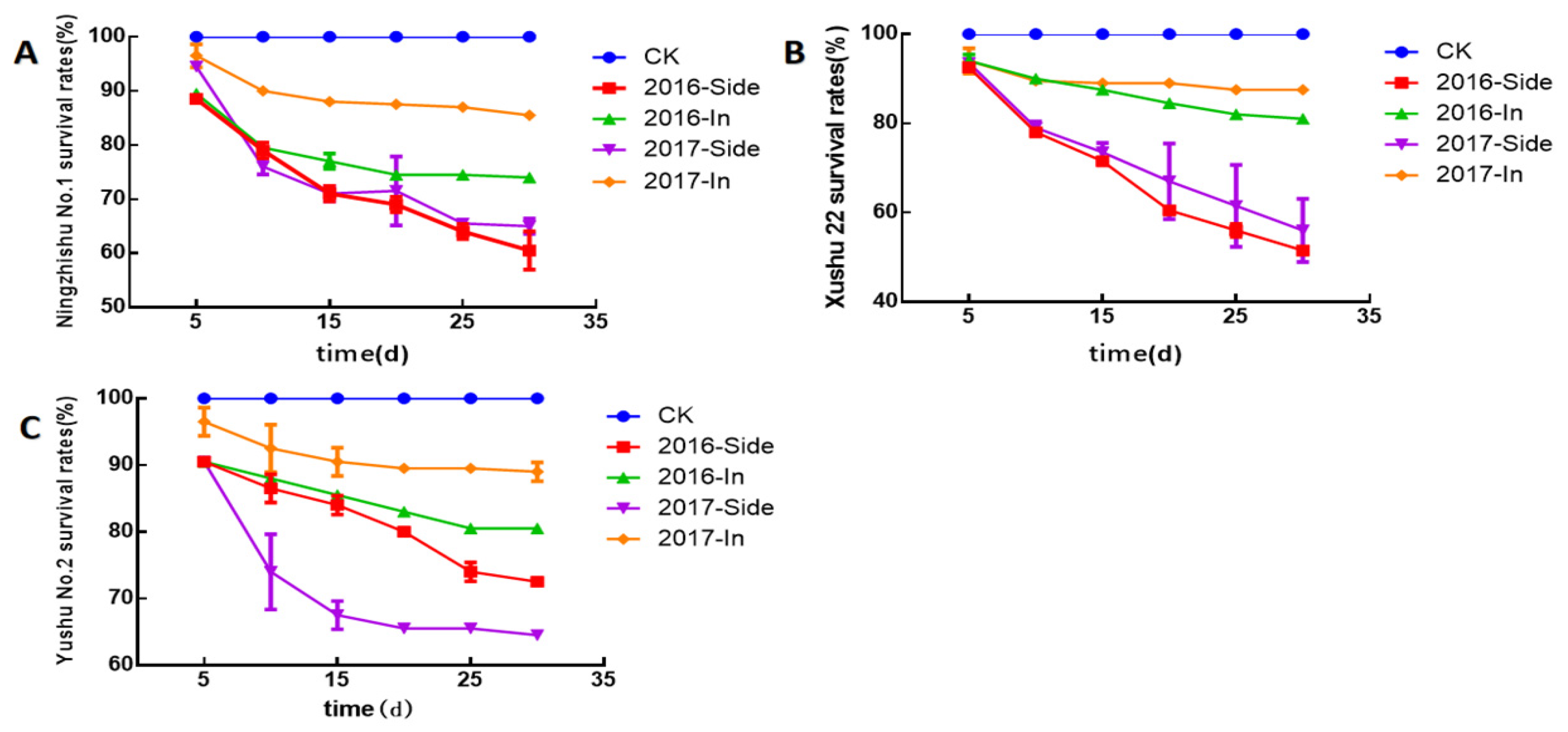
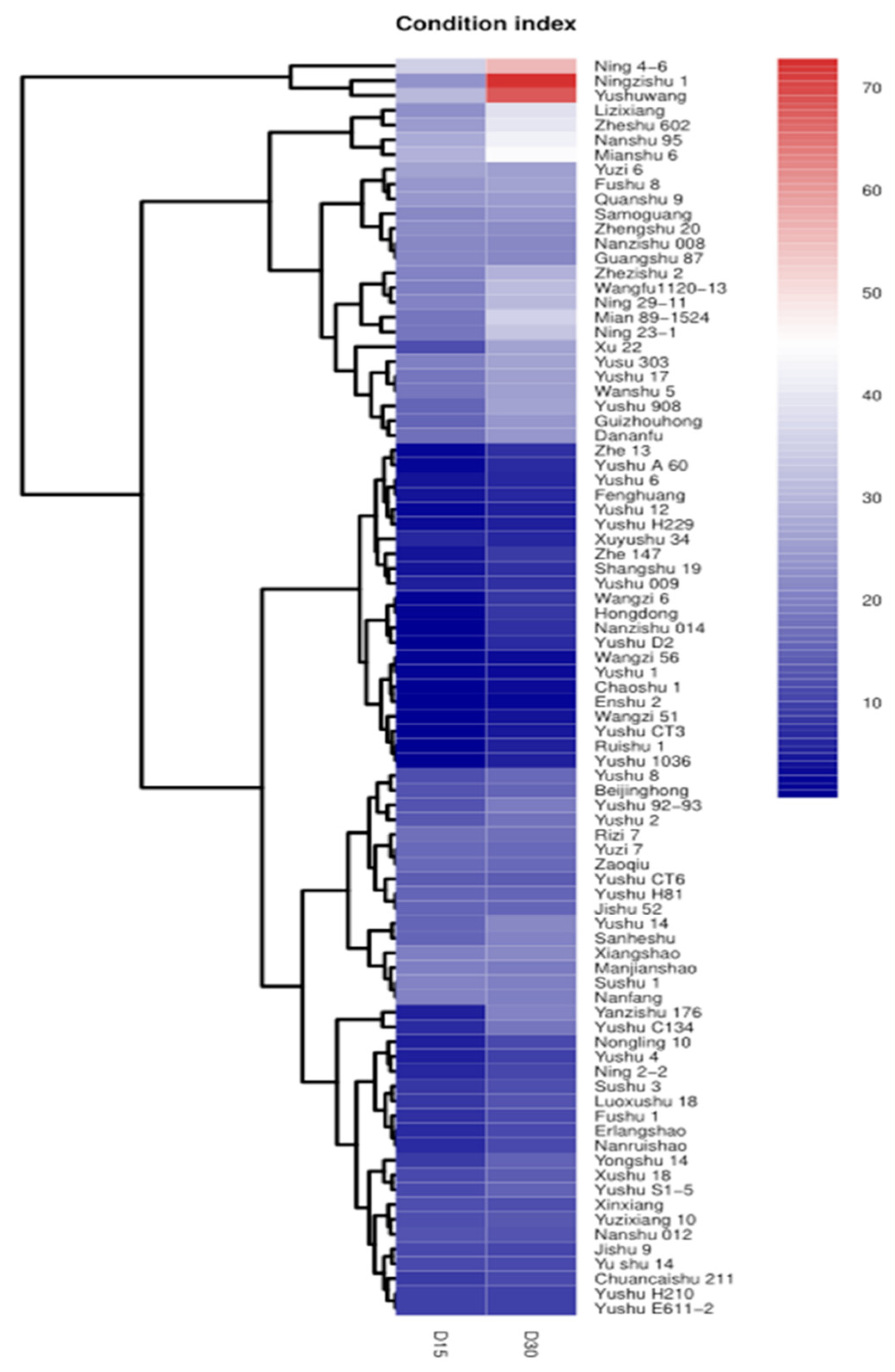
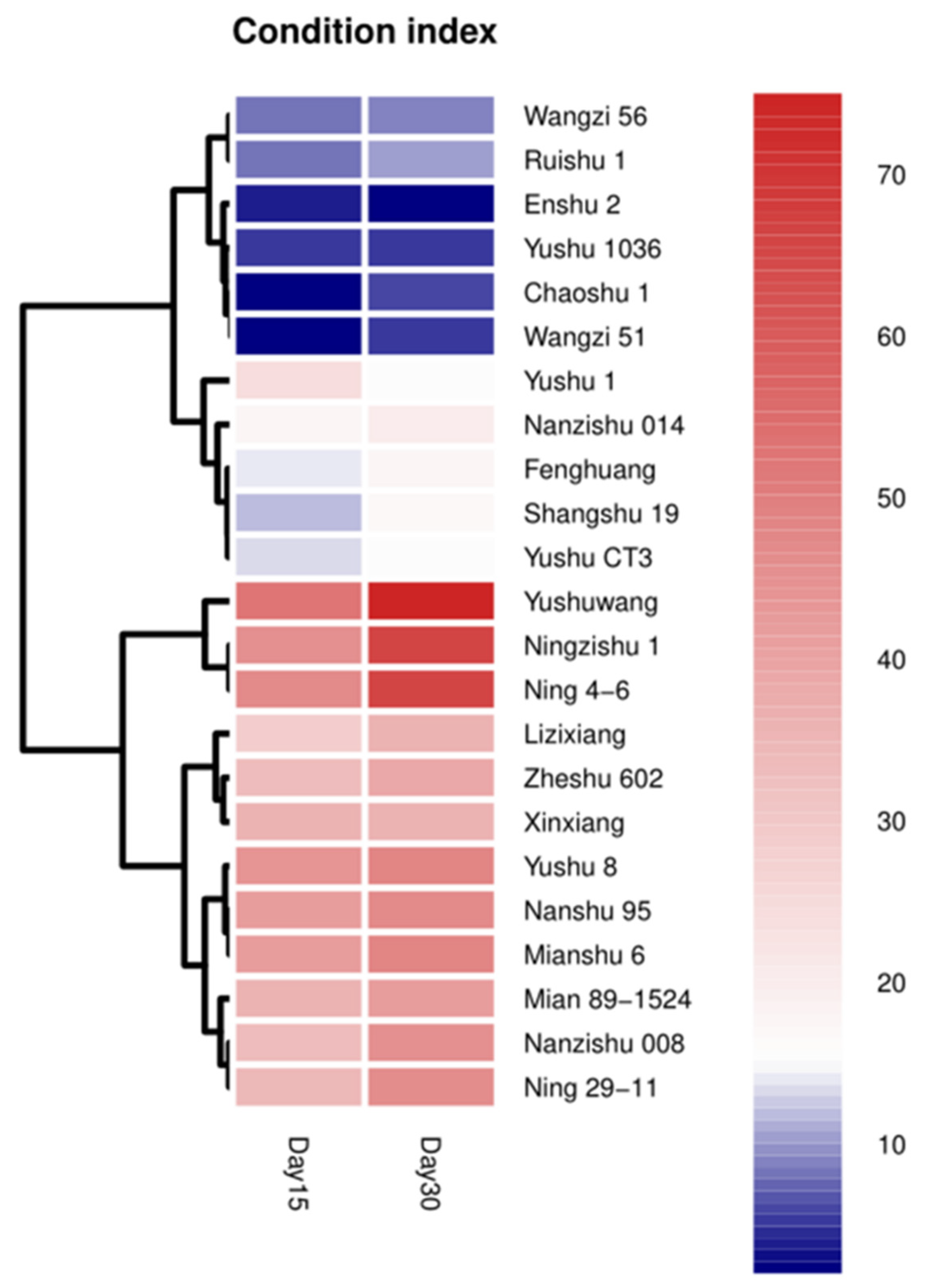
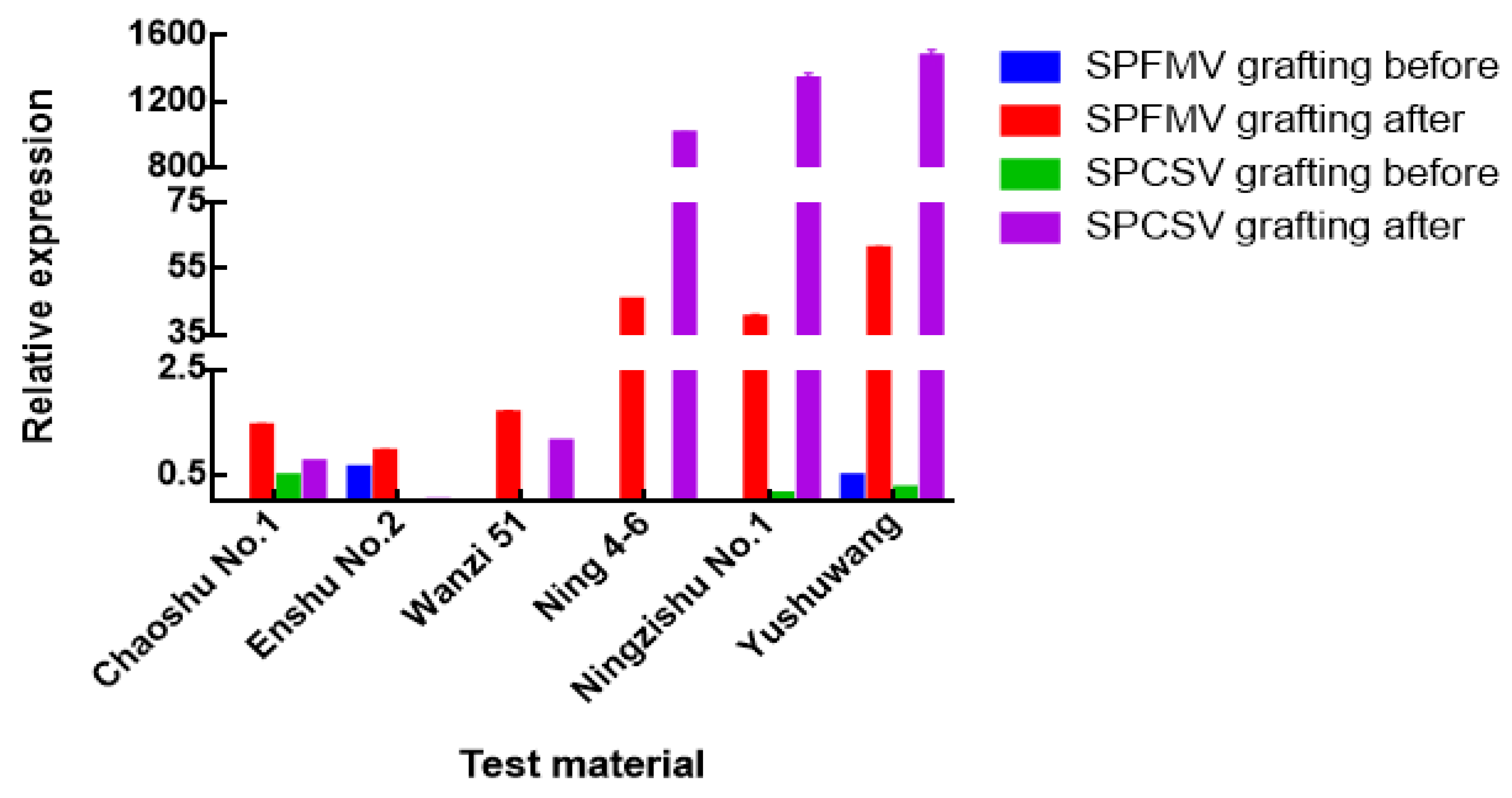
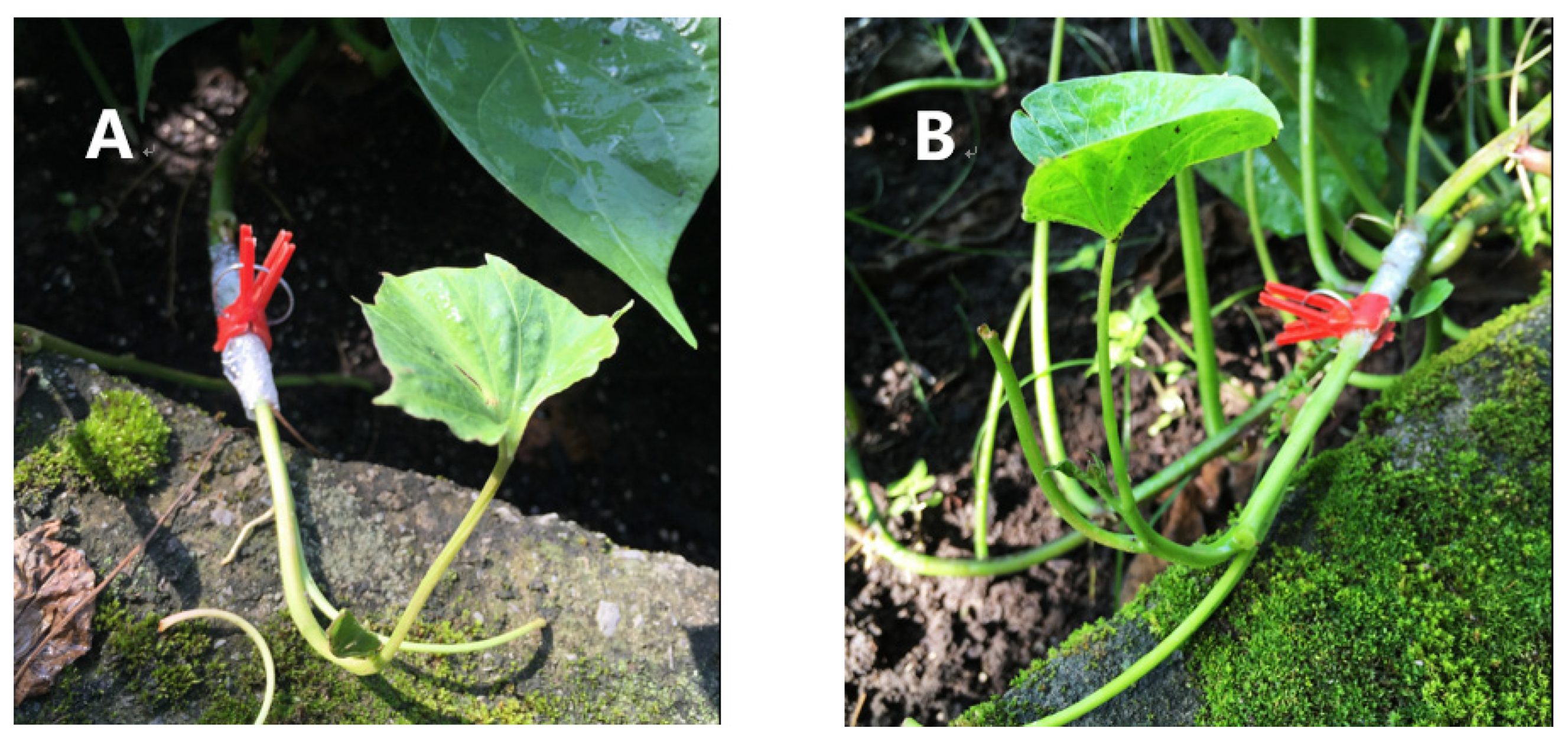
| Variety Name | Origin | Disease Index Calculated at 15 DAG | Disease Index Calculated at 30 DAG |
|---|---|---|---|
| Enshu No.2 | Hubei, China | 1.43 ± 0 uvTU | 2.86 ± 2.02 yT |
| Wanzi 56 | Chongqing, China | 1.43 ± 2.02 uvTU | 3.57 ± 3.03 xyST |
| Yushu No.1 | Chongqing, China | 2.14 ± 1.01 tuvTU | 3.57 ± 3.03 xyST |
| Chaoshu No.1 | Fujian, China | 1.43 ± 0 uvTU | 3.57 ± 3.03 xyST |
| Wanzi 51 | Chongqing, China | 0.71 ± 1.01 vU | 4.29 ± 0.00 wxyRST |
| Yushu CT3 | Chongqing, China | 1.43 ± 0 uvTU | 5.00 ± 1.01 vwxyQRST |
| Ruishu No.1 | Gansu, China | 1.43 ± 0 uvTU | 5.71 ± 0.00 uvwxyPQRST |
| Yushu 12 | Chongqing, China | 2.86 ± 0 stuvSTU | 5.71 ± 0.00 uvwxyPQRST |
| Yushu H229 | Chongqing, China | 3.57 ± 3.03 rstuvRSTU | 5.71 ± 4.04 uvwxyPQRST |
| Xuyushu 34 | Chongqing, China | 6.43 ± 1.01 pqrstuvPQRSTU | 6.43 ± 1.01 uvwxyOPQRST |
| Yushu 1036 | Chongqing, China | 1.43 ± 2.02 uvTU | 6.43 ± 1.01 uvwxyOPQRST |
| Yushu A 60 | Chongqing, China | 2.86 ± 0 stuvSTU | 7.14 ± 0.00 tuvwxyOPQRST |
| Yushu D2 | Chongqing, China | 1.43 ± 0 uvTU | 7.14 ± 2.02 tuvwxyOPQRST |
| fenghuang | Chongqing, China | 4.29 ± 2.02 rstuvQRSTU | 7.14 ± 2.02 tuvwxyOPQRST |
| Shangshu 19 | Henan, China | 4.29 ± 2.02 rstuvQRSTU | 7.86 ± 1.01 stuvwxyNOPQRST |
| Nanzishu 014 | Sichuan, China | 0.71 ± 1.01 vU | 7.86 ± 1.01 stuvwxyNOPQRST |
| Yushu 009 | Chongqing, China | 5.71 ± 2.02 qrstuvPQRSTU | 7.86 ± 1.01 stuvwxyNOPQRST |
| Yushu No.6 | Chongqing, China | 2.86 ± 0.00 stuvSTU | 7.86 ± 3.03 stuvwxyNOPQRST |
| Wanzi No.6 | Chongqing, China | 2.14 ± 1.01 tuvTU | 8.57 ± 2.02 rstuvwxyMNOPQRST |
| Hongdong | Japan | 2.14 ± 1.01 tuvTU | 8.57 ± 0.00 rstuvwxyMNOPQRST |
| Zhe 13 | Zhejiang, China | 2.86 ± 0.00 stuvSTU | 8.57 ± 2.02 rstuvwxyMNOPQRST |
| Zhe 147 | Zhejiang, China | 4.29 ± 0.00 rstuvQRSTU | 9.29 ± 5.05 qrstuvwxyMNOPQRST |
| Yushu No.4 | Chongqing, China | 5.71 ± 0.00 qrstuvPQRSTU | 10.00 ± 4.04 pqrstuvwxyLMNOPQRST |
| Yushu E611-2 | Chongqing, China | 10.00 ± 0.00 mnopqrLMNOPQRST | 10.00 ± 0.00 pqrstuvwxyLMNOPQRST |
| Yushu H210 | Chongqing, China | 10.00 ± 2.02 mnopqrLMNOPQRST | 10 ± 2.02 pqrstuvwxyLMNOPQRST |
| Yushu 14 | Henan, China | 11.43 ± 2.02 lmnopqKLMNOPQRS | 11.43 ± 2.02 opqrstuvwxyKLMNOPQRST |
| Ning 2-2 | Ningxia, China | 6.43 ± 5.05 pqrstuvPQRSTU | 11.43 ± 0.00 opqrstuvwxyKLMNOPQRST |
| Erlangshao | Chongqing, China | 7.14 ± 2.02 pqrstuvOPQRSTU | 11.43 ± 2.02 opqrstuvwxyKLMNOPQRST |
| Nongling 10 | Chongqing, China | 5.71 ± 0.00 qrstuvPQRSTU | 11.43 ± 2.02 opqrstuvwxyKLMNOPQRST |
| Fushu No.1 | Fujian, China | 7.86 ± 1.01 opqrstuNOPQRSTU | 11.43 ± 6.06 opqrstuvwxyKLMNOPQRST |
| Nanruishao | Yunnan, China | 7.14 ± 0.00 pqrstuvOPQRSTU | 11.43 ± 0.00 opqrstuvwxyKLMNOPQRST |
| Xinxiang | Zhejiang, China | 20.00 ± 2.02 efghijDEFGHIJK | 12.14 ± 3.03 nopqrstuvwxyKLMNOPQRST |
| Sushu No.3 | Suzhou, China | 8.57 ± 0.00 opqrstMNOPQRSTU | 12.14 ± 5.05 nopqrstuvwxyKLMNOPQRST |
| Chuancaishu 211 | Sichuan, China | 9.29 ± 1.01 nopqrsMNOPQRSTU | 12.14 ± 1.01 nopqrstuvwxyKLMNOPQRST |
| Nanshu 012 | Sichuan, China | 12.86 ± 0.00 klmnopIJKLMNOPQ | 12.86 ± 0.00 mnopqrstuvwxyJKLMNOPQRST |
| Luoxushu 18 | Jiangsu, China | 8.57 ± 0.00 opqrstMNOPQRSTU | 12.86 ± 2.02 mnopqrstuvwxyJKLMNOPQRST |
| Jishu No.9 | Shandong, China | 11.43 ± 0.00 lmnopqKLMNOPQRS | 13.57 ± 5.05 mnopqrstuvwxyJKLMNOPQRST |
| Yuzixiang 10 | Chongqing, China | 12.14 ± 7.07 klmnopqJKLMNOPQR | 13.57 ± 1.01 mnopqrstuvwxyJKLMNOPQRST |
| Yushu CT6 | Chongqing, China | 14.29 ± 0.00 jklmnoHIJKLMNOP | 14.29 ± 0.00 lmnopqrstuvwxyIJKLMNOPQRST |
| Xushu 18 | Jiangsu, China | 11.43 ± 0.00 lmnopqKLMNOPQRS | 15.00 ± 1.01 klmnopqrstuvwxyHIJKLMNOPQRST |
| Yushu S1-5 | Chongqing, China | 11.43 ± 0.00 lmnopqKLMNOPQRS | 15.71 ± 2.02 jklmnopqrstuvwxHIJKLMNOPQRST |
| Yushu H81 | Chongqing, China | 15.71 ± 0.00 ijklmnGHIJKLMNO | 15.71 ± 0.00 jklmnopqrstuvwxHIJKLMNOPQRST |
| Yongshu 14 | Chongqing, China | 9.29 ± 3.03 nopqrsMNOPQRSTU | 15.71 ± 10.1 jklmnopqrstuvwxHIJKLMNOPQRST |
| Jishu 52 | Hebei, China | 15.71 ± 6.06 ijklmnGHIJKLMNO | 15.71 ± 6.06 jklmnopqrstuvwxHIJKLMNOPQRST |
| Zaoqiu | Hebei, China | 16.43 ± 9.09 hijklmFGHIJKLMN | 16.43 ± 9.09 jklmnopqrstuvwHIJKLMNOPQRST |
| Yushu No.8 | Chongqing, China | 8.57 ± 0.00 opqrstMNOPQRSTU | 16.43 ± 3.03 jklmnopqrstuvwHIJKLMNOPQRST |
| Yuzi No.7 | Chongqing, China | 16.43 ± 1.01 hijklmFGHIJKLMN | 16.43 ± 1.01 jklmnopqrstuvwHIJKLMNOPQRST |
| Beijinghong | Beijing, China | 12.86 ± 2.02 klmnopIJKLMNOPQ | 16.43 ± 3.03 jklmnopqrstuvwHIJKLMNOPQRST |
| Rizi No.7 | Japan | 17.14 ± 6.06 ghijklFGHIJKLM | 17.14 ± 6.06 ijklmnopqrstuvGHIJKLMNOPQRST |
| Yushu No.2 | Chongqing, China | 12.14 ± 1.01 klmnopqJKLMNOPQR | 17.86 ± 1.01 ijklmnopqrstuGHIJKLMNOPQRST |
| Yushu C134 | Chongqing, China | 7.14 ± 0.00 pqrstuvOPQRSTU | 19.29 ± 15.15 hijklmnopqrstGHIJKLMNOPQRST |
| Manjianshao | Chongqing, China | 20.00 ± 0.00 efghijDEFGHIJK | 19.29 ± 1.01 hijklmnopqrstGHIJKLMNOPQRST |
| Yushu 92-93 | Chongqing, China | 12.86 ± 0.00 klmnopIJKLMNOPQ | 20.00 ± 4.04 hijklmnopqrsFGHIJKLMNOPQRS |
| Sanheshu | Sichuan, China | 15.71 ± 0.00 ijklmnGHIJKLMNO | 20.71 ± 3.03 hijklmnopqrFGHIJKLMNOPQR |
| Yanzishu 176 | Shandong, China | 5.71 ± 0.00 qrstuvPQRSTU | 20.71 ± 5.05 hijklmnopqrFGHIJKLMNOPQR |
| Yushu 14 | Chongqing, China | 15.71 ± 4.04 ijklmnGHIJKLMNO | 21.43 ± 6.06 ghijklmnopqFGHIJKLMNOPQ |
| Nanzishu 008 | Chongqing, China | 21.43 ± 6.06 defghiCDEFGHI | 21.43 ± 6.06 ghijklmnopqFGHIJKLMNOPQ |
| Guangshu 87 | Guangdong, China | 21.43 ± 2.02 defghiCDEFGHI | 21.43 ± 2.02 ghijklmnopqFGHIJKLMNOPQ |
| Xiangshao | Sichuan, China | 20.00 ± 0.00 efghijDEFGHIJK | 21.43 ± 8.08 ghijklmnopqFGHIJKLMNOPQ |
| Zhengshu 20 | Zhengzhou, China | 22.14 ± 3.03 defghiCDEFGH | 22.14 ± 3.03 ghijklmnopFGHIJKLMNOP |
| Nanfang | Chongqing, China | 20.71 ± 1.01 efghijCDEFGHIJ | 22.86 ± 2.02 ghijklmnoEFGHIJKLMNO |
| Sushu No.1 | Jiangsu, China | 20.71 ± 1.01 efghijCDEFGHIJ | 22.86 ± 2.02 ghijklmnoEFGHIJKLMNO |
| Guizhouhong | Guizhou, China | 15.71 ± 0.00 ijklmnGHIJKLMNO | 24.29 ± 2.02 fghijklmnDEFGHIJKLMN |
| Samoguang | Japan | 21.43 ± 0.00 defghiCDEFGHI | 24.29 ± 0 fghijklmnDEFGHIJKLMN |
| Dananfu | Sichuan, China | 17.14 ± 0.00 ghijklFGHIJKLM | 25.00 ± 1.01 fghijklmDEFGHIJKLM |
| Quanshu No.9 | Fujiang, China | 24.29 ± 0.00 cdefBCDEFG | 25.00 ± 3.03 fghijklmDEFGHIJKLM |
| Yushu 908 | Chongqing, China | 15.71 ± 4.04 ijklmnGHIJKLMNO | 26.43 ± 1.01 efghijklDEFGHIJKL |
| Yushu 8 | Henan, China | 25.00 ± 1.01 bcdefBCDEF | 26.43 ± 1.01 efghijklDEFGHIJKL |
| Yushu 17 | Chongqing, China | 18.57 ± 0.00 fghijkEFGHIJKL | 26.43 ± 3.03 efghijklDEFGHIJKL |
| Fushu No.8 | Fujian, China | 24.29 ± 0.00 cdefBCDEFG | 26.43 ± 5.05 efghijklDEFGHIJKL |
| Xu 22 | Jiangsu, China | 12.14 ± 1.01 klmnopqJKLMNOPQR | 26.43 ± 3.03 efghijklDEFGHIJKL |
| Yusu 303 | Chongqing, China | 20.00 ± 0.00 efghijDEFGHIJK | 27.14 ± 0.00 efghijkDEFGHIJK |
| Wanshu No.5 | Chongqing, China | 18.57 ± 4.04 fghijkEFGHIJKL | 27.86 ± 11.11 efghijDEFGHIJK |
| Yuzi No.6 | Chongqing, China | 26.43 ± 1.01 bcdeBCDE | 27.86 ± 1.01 efghijDEFGHIJK |
| Zhezishu No.2 | Zhejiang, China | 20.71 ± 1.01 efghijCDEFGHIJ | 29.29 ± 1.01 defghiDEFGHIJ |
| Ning 29-11 | Jiangsu, China | 20.71 ± 5.05 efghijCDEFGHIJ | 30.71 ± 7.07 defghDEFGHI |
| Wanfu 1120-13 | Zhejiang, China | 12.14 ± 3.03 klmnopqJKLMNOPQR | 31.43 ± 6.06 defghDEFGH |
| Ning 23-1 | Jiangsu, China | 18.57 ± 4.04 fghijkEFGHIJKL | 33.57 ± 3.03 defgCDEFG |
| Mian 89-1524 | Sichuan, China | 18.57 ± 10.1 fghijkEFGHIJKL | 35.71 ± 14.14 defBCDEF |
| Lizixiang | Chongqing, China | 22.86 ± 8.08 cdefghBCDEFGH | 38.57 ± 14.14 cdeBCDE |
| Zheshu 602 | Zhejiang, China | 25.00 ± 5.05 bcdefBCDEF | 40.00 ± 6.06 cdBCD |
| Nanshu 95 | Sichuan, China | 27.86 ± 1.01 bcdABCD | 47.86 ± 1.01 cBC |
| Mianshu No.6 | Sichuan, China | 29.29 ± 3.03 abcABC | 48.57 ± 10.1 cB |
| Ning 4-6 | Jiangsu, China | 35.00 ± 1.01 aA | 63.57 ± 11.11 bA |
| Yushuwang | Henan, China | 30.71 ± 1.01 abAB | 72.14 ± 11.11 abA |
| Ningzishu No.1 | Jiangsu, China | 23.57 ± 1.01 cdefgBCDEFG | 75.00 ± 13.13 aA |
| Variety Name | 15-Day Disease Index | Variety Name | 30-Day Disease Index |
|---|---|---|---|
| Wanzi 51 | 2.14 ± 1.01 iH | Enshu No.2 | 2.86 ± 0 ijF |
| Enshu No.2 | 2.14 ± 1.01 iH | Chaoshu No.1 | 5.00 ± 1.01 ijEF |
| Chaoshu No.1 | 2.14 ± 1.01 iH | Wanzi 51 | 5.00 ± 1.01 ijEF |
| Yushu No.1 | 5.00 ± 1.01 hiH | Yushu 1036 | 5.71 ± 0.00 ijEF |
| Yushu 1036 | 5.00 ± 5.05 hiH | Yushu No.1 | 6.43 ± 3.03 ijEF |
| Wanzi 56 | 7.86 ± 1.01 ghiGH | Wanzi 56 | 9.29 ± 1.01 hiDEF |
| Ruishu No.1 | 8.57 ± 2.02 ghiGH | Ruishu No.1 | 10.71 ± 3.03 ghiDEF |
| Shangshu 19 | 12.14 ± 1.01 fghGH | Yushu CT3 | 15.71 ± 2.02 fghDE |
| Yushu CT3 | 13.57 ± 1.01 fghGH | Shangshu 19 | 17.14 ± 2.02 fgD |
| Fenghuang | 14.29 ± 4.04 fgGH | Fenghuang | 17.86 ± 1.01 fgD |
| Nanzishu 014 | 17.86 ± 3.03 fFG | Nanzishu 014 | 20.00 ± 2.02 fD |
| Lizixiang | 28.57 ± 0.00 eEF | Lizixiang | 35.71 ± 2.02 eC |
| Zheshu 602 | 32.86 ± 2.02 deDE | Yushu No.8 | 35.71 ± 2.02 eC |
| Nanzishu 008 | 32.86 ± 2.02 deDE | Zheshu 602 | 38.57 ± 6.06 deBC |
| Ning 29-11 | 34.29 ± 8.08 deCDE | Mian 89-1524 | 41.43 ± 6.06 cdeBC |
| Yushu No.8 | 35.71 ± 10.1 cdeBCDE | Nanzishu 008 | 45.71 ± 8.08 cdBC |
| Mian 89-1524 | 35.71 ± 2.02 cdeBCDE | Ning 29-11 | 46.43 ± 1.01 cBC |
| Nanshu 95 | 41.43 ± 2.02 bcdABCD | Nanshu 95 | 47.14 ± 6.06 cB |
| Mianshu No.6 | 41.43 ± 2.02 bcdABCD | Xinxiang | 48.57 ± 4.04 cB |
| Xinxiang | 44.29 ± 2.02 abcABCD | Mianshu No.6 | 48.57 ± 0.00 cB |
| Ningzishu No.1 | 45.71 ± 4.04 abABC | Ning 4-6 | 65.71 ± 4.04 bA |
| Ning 4-6 | 47.14 ± 6.06 abAB | Ningzishu No.1 | 65.71 ± 4.04 bA |
| Yushuwang | 52.86 ± 6.06 aA | Yushuwang | 75.00 ± 1.01 aA |
| Variety Name | NCM-ELISA | Variety Name | NCM-ELISA | ||
|---|---|---|---|---|---|
| SPCSV | SPFMV | SPCSV | SPFMV | ||
| Enshu No.2 | − | − | Jishu 52 | − | − |
| Wanzi 56 | − | − | Zaoqiu | − | + |
| Yushu No.1 | − | − | Yushu No.8 | − | − |
| Chaoshu No.1 | − | − | Yuzi No.7 | − | − |
| Wanzi 51 | − | − | Beijinghong | − | − |
| Yushu CT3 | − | − | Rizi No.7 | − | − |
| Ruishu No.1 | − | − | Yushu No.2 | − | − |
| Yushu 12 | − | − | Yushu C134 | − | − |
| Yushu H229 | − | − | Manjianshao | − | − |
| Xuyushu 34 | − | − | Yushu 92-93 | − | − |
| Yushu 1036 | − | − | Sanheshu | − | + |
| Yushu A 60 | − | − | Yanzishu 176 | − | + |
| Yushu D2 | − | − | Yushu 14 | − | − |
| Fenghuang | − | − | Nanzishu 008 | + | + |
| Shangshu 19 | − | − | Guangshu 87 | − | + |
| Nanzishu 014 | − | − | Xiangshao | − | + |
| Yushu 009 | − | − | Zhengshu 20 | − | + |
| Yushu No.6 | − | − | Nanfang | − | + |
| Wanzi No.6 | − | − | Sushu No.1 | − | + |
| Hongdong | − | − | Guizhouhong | − | + |
| Zhe 13 | − | − | Samoguang | − | − |
| Zhe 147 | − | − | Dananfu | − | + |
| Yushu No.4 | − | − | Quanshu No.9 | − | + |
| Yushu E611-2 | − | − | Yushu 908 | − | + |
| Yushu H210 | − | − | Yushu 8 | − | − |
| Yushu 14 | − | + | Yushu 17 | − | + |
| Ning 2-2 | − | − | Fushu No.8 | − | + |
| Erlangshao | − | − | Xu 22 | − | + |
| Nongling 10 | − | − | Yusu 303 | − | + |
| Fushu No.1 | − | − | Wanshu No.5 | − | + |
| Nanruishao | − | − | Yuzi No.6 | − | + |
| Xinxiang | + | + | Zhezishu No.2 | − | + |
| Sushu No.3 | − | − | Ning 29-11 | + | + |
| Chuancaishu 211 | − | − | Wanfu 1120-13 | − | − |
| Nanshu 012 | − | − | Ning 23-1 | − | + |
| Luoxushu 18 | − | − | Mian 89-1524 | + | + |
| Jishu No.9 | − | − | Lizixiang | + | + |
| Yuzixiang 10 | − | − | Zheshu 602 | + | + |
| Yushu CT6 | − | − | Nanshu 95 | + | + |
| Xushu 18 | − | − | Mianshu No.6 | + | + |
| Yushu S1-5 | − | − | Ning 4-6 | + | + |
| Yushu H81 | − | − | Yushuwang | + | + |
| Yongshu 14 | − | − | Ningzishu No.1 | + | + |
| Primer Name | Forward Reverse Primer | Size of PCR Product (bp) |
|---|---|---|
| F (SPFMV) | 5′-TGTGCCTCTCCGTATCYTCTTCTTGCGT-3′ | 149 |
| R (SPFMV) | 5′-GACTGATATGAGTCTTGCGCGRTATGCG-3′ | |
| F (SPCSV) | 5′-CCCAACGTGTTTATCTATTACTAAGAGTGG-3′ | 170 |
| R (SPCSV) | 5′-AATACTGGGGAGCTATCTTACGTTTGA-3′ | |
| RIbUBI | 5′-CTTGAT CTTCTTCGGCTTGG-3′ | |
| FIbH2 B | 5′-GTGCCGGAGACAAGAAGAAG- 3′ | 110 |
| RIbH2 B | 5′-CTTGCTGGAGATTCCGATGT-3′ |
Disclaimer/Publisher’s Note: The statements, opinions and data contained in all publications are solely those of the individual author(s) and contributor(s) and not of MDPI and/or the editor(s). MDPI and/or the editor(s) disclaim responsibility for any injury to people or property resulting from any ideas, methods, instructions or products referred to in the content. |
© 2023 by the authors. Licensee MDPI, Basel, Switzerland. This article is an open access article distributed under the terms and conditions of the Creative Commons Attribution (CC BY) license (https://creativecommons.org/licenses/by/4.0/).
Share and Cite
Huang, H.; Han, H.; Lei, Y.; Qiao, H.; Tang, D.; Han, Y.; Deng, Z.; Mao, L.; Wu, X.; Zhang, K.; et al. Application of Grafting Method in Resistance Identification of Sweet Potato Virus Disease and Resistance Evaluation of Elite Sweet Potato [Ipomoea batatas (L.) Lam] Varieties. Plants 2023, 12, 957. https://doi.org/10.3390/plants12040957
Huang H, Han H, Lei Y, Qiao H, Tang D, Han Y, Deng Z, Mao L, Wu X, Zhang K, et al. Application of Grafting Method in Resistance Identification of Sweet Potato Virus Disease and Resistance Evaluation of Elite Sweet Potato [Ipomoea batatas (L.) Lam] Varieties. Plants. 2023; 12(4):957. https://doi.org/10.3390/plants12040957
Chicago/Turabian StyleHuang, Hong, Haohao Han, Yayun Lei, Huanhuan Qiao, Daobin Tang, Yonghui Han, Zhenpeng Deng, Limin Mao, Xuli Wu, Kai Zhang, and et al. 2023. "Application of Grafting Method in Resistance Identification of Sweet Potato Virus Disease and Resistance Evaluation of Elite Sweet Potato [Ipomoea batatas (L.) Lam] Varieties" Plants 12, no. 4: 957. https://doi.org/10.3390/plants12040957
APA StyleHuang, H., Han, H., Lei, Y., Qiao, H., Tang, D., Han, Y., Deng, Z., Mao, L., Wu, X., Zhang, K., Wang, J., & Lv, C. (2023). Application of Grafting Method in Resistance Identification of Sweet Potato Virus Disease and Resistance Evaluation of Elite Sweet Potato [Ipomoea batatas (L.) Lam] Varieties. Plants, 12(4), 957. https://doi.org/10.3390/plants12040957






